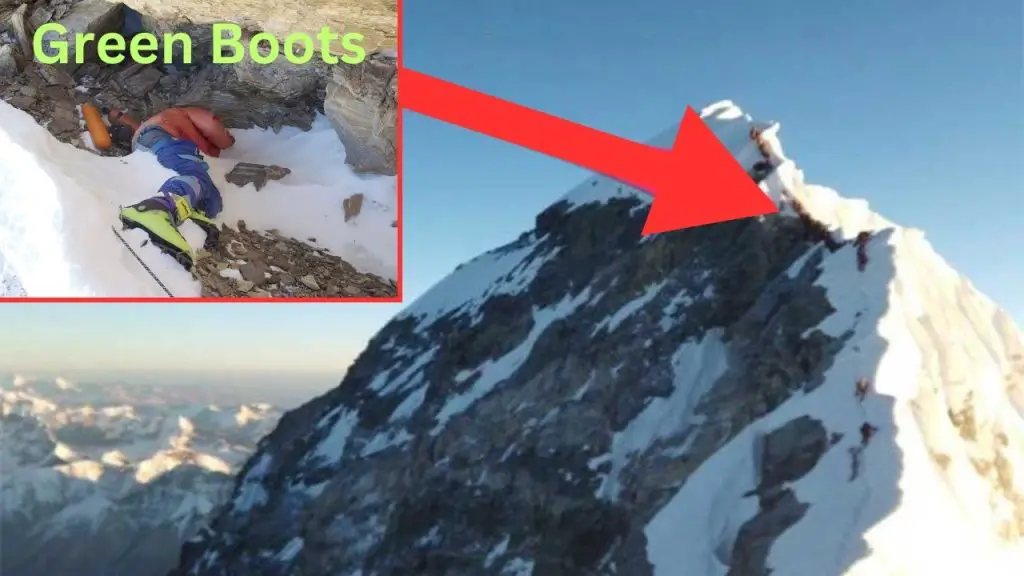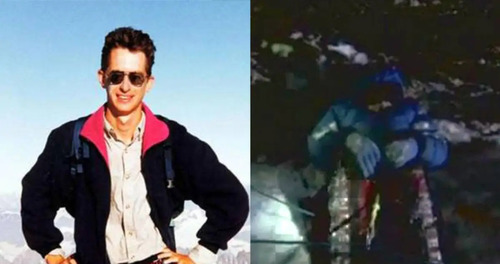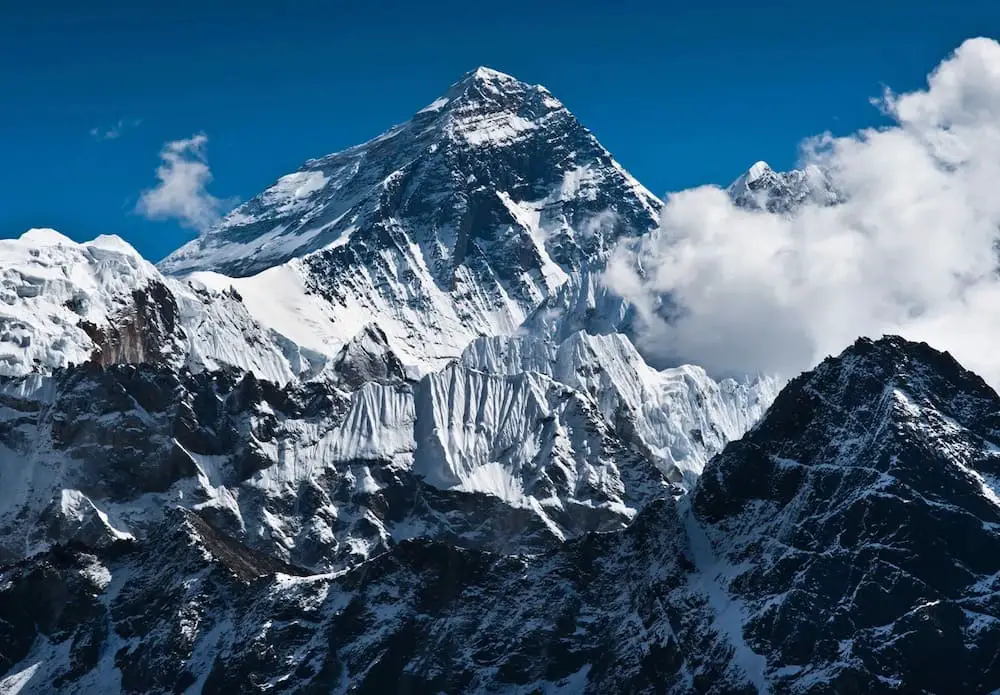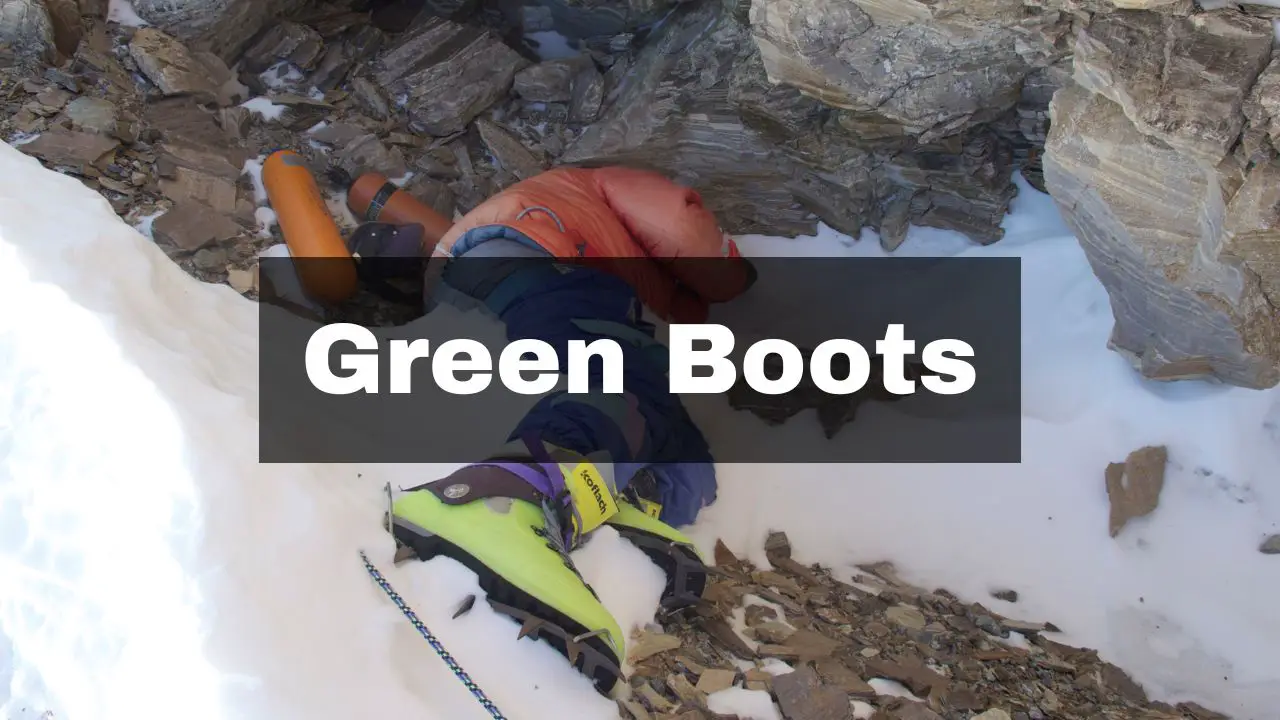Mount Everest is one of the most dangerous mountains to summit and that was no different on May 10, 1996 when Green Boots died on the Tibetan side of Everest. Tsewang Paljor, now commonly known as Green Boots, is one of the most famous dead bodies on Mount Everest.
Green Boots on Mount Everest, an unconfirmed climber, has come to symbolize the dangers of conquering the world’s highest peak. The nickname is attributed to the green Koflach boots he wore during his fatal expedition in May 1996.
Resting within a limestone cave on the Northeast ridge route, Green Boots has become a marker for climbers. He was found at an altitude of 8,500 meters (or 27,900 ft) until being relocated in 2014. Now a controversial landmark, Tsewang Paljor is one of the many climbers who have died in the Rainbow Valley portion of the Death Zone.
Key Takeaways – Green Boots on Everest:
- Green Boots was 28 when he died on Everest
- Green Boots died in May 1996 on the Northeast Ridge Route of Everest.
- It is believed that Green Boots is actually Indian climber Tsewang Paljor
- His body remains on Mount Everest, although it is covered now
- Another climber, David Sharp had a controversial death in the same cave in 2006
Who was Green Boots?
It is widely believed that Tsewang Paljor is Green Boots on Everest.
However, the body has never positively been identified due to its location. Therefore, a contradicting theory has also emerged. It is believed that Green Boots is is either Tsewang Paljor or Dorje Morup of India.
Green Boots as Tsewang Paljor Theory:

Green Boots’ real name is believed to be Tsewang Paljor from India. In 1996, he was part of an expedition attempting to summit Everest from the North Ridge.
On May 10, 1996, a severe blizzard struck the mountain, and several climbers, including Paljor, were caught in the storm. Paljor and his two teammates were from the Indo-Tibetan Border Police (ITBP) from India. The three were unable to descend in time and died in the storm. They were three of the eight climbers that died in the 1996 Mount Everest Disaster.
Green boots was one of eight climbers who passed away on Mount Everest during one of the deadliest single-day events in Everest’s history. On the same day, other prominent climbers like Scott Fischer and Rob Hall had also met their fate.
Additionally, the event gave rise to one of the most well known movies about Everest: the 2015 ‘Everest.’
Theory of Dorje Morup as Green Boots:

While Everest’s Green Boots is often thought to be Tsewang Paljor, another theory suggests that Dorje Morup is this enduring symbol. The theory was proposed in the ‘The Indian Ascent of Qomolungma by the North Ridge‘ 1997 article by P. M. Das.
Das reported sighting two climbers descending with torches at 19:30, but they soon disappeared from view. The next day, the second summit group leader radioed encountering Morup between the First and Second Steps, struggling with frost-bitten hands to unclip his safety carabiner. A Japanese team helped him transition to the next rope section.
Unexpectedly, the Japanese group found Tsewang Smanla’s body above the Second Step. On their return, they saw Morup progressing slowly, possibly succumbing to death late on May 11. Das maintains they never found Paljor’s body.
In another encounter, a second ITBP group found Smanla and Morup’s bodies during their descent, with Morup found under a boulder close to Camp 6, intact clothing and rucksack nearby. This prompts speculation that the enduring figure of Green Boots, often thought to be Tsewang Paljor, might be Dorje Morup instead.
Who was Tsewang Paljor?

During his childhood, Tsewang was reserved and kept to himself. With a gentle and compassionate nature he was the eldest son in a struggling family. Paljor felt the responsibility to support them, prompting him to leave school after 10th grade. Raised in Ladakh, a mountainous village, typically boys ended formal education around 8th grade to seek work. Many pursued driving, tourism, or the army. Soon after leaving school, he chose to join the Indo-Tibetan Border Police, an organization specialized in high-altitude operations. His mother, Tashi Angmo, fully supported his choice.
In 1996, an elite climbing team from the Indo-Tibetan border police was formed to summit Mount Everest. Tsewang Paljor was selected as a member. Despite his mother’s pleas to not go, he continued on as he believed summiting Everest would benefit the family. His last goodbye came from his brother-in-law Namgyal in Delhi.
The risks of Everest are numerous, even for a strong and experienced climber like Paljor. However, according to his Commander Singh, Paljor had a fondness for challenging rock climbs. Often resembling a monkey in his climbing style. Unfortunately, even though Tsewang Paljor was well suited for the climb, he ultimately lost his life, along with two other teammates.
Where is Green Boots Body on Everest?

Green Boots’ body was left on the mountain after his death, and it is now located in a small cave-like crevice on Everest. The cave is situated at an altitude of around 27,890 feet, just below the summit of Everest. It is one of the most visible landmarks on the mountain and is passed by many climbers attempting to summit via the North Ridge.
The location of Green Boots is inside the Death Zone and is part of the famous Rainbow Valley on Everest. With over 200 people dying on Everest, Green Boots’ location has become one of the many unfortunate, colorful reminders of a climber’s demise.
Green Boots in his cave on Everest:
The cave on Everest that Green Boots spent over 20 years in is a small alcove that is located right next to the Northridge climbing route. Climbers report being eerily close to the dead body as the climbing rope falls on his outstretched feet.
A video of Green Boots’ Cave with Tsewang Paljor inside can be seen below. Paljor can be seen at the 42:31 mark in the Summit Fever – Brian Blessed Documentary.
The Importance of Green Boots
The presence of Green Boots on Everest has become an important symbol for climbers attempting to summit the mountain. The body is a reminder of the dangers of climbing Everest and the importance of being prepared for the harsh conditions on the mountain. Additionally, the body acts as a marker for many as they climb the North side of the mountain.
The story of Green Boots has also had an impact on the climbing community. It has become a cautionary tale often discussed among climbers, and his death has been used as an example of the dangers of climbing Everest. The tale was reignited in 2006, when David Sharp died.
Death of David Sharp in Green Boot’s Cave:

Exactly two decades after Green Boots’ death in 1996, a 34-year-old British man named David Sharp met a similar fate in the same cave. Hiking solo, Sharp fell victim to hypothermia and sought shelter in the cave. Around 40 other climbers passed by him. Sadly, many climbers didn’t assist, confusing him with “Green Boots” or assuming he had already died.
When it was finally realized that Sharp needed aid, it was too late. Sharp’s death further highlighted the harsh reality of the unforgiving mountain environment. Not just in terms of physical demands, but also as humans, as climbers get left behind to die in hopes of a summit bids. Following Sharp’s family’s wishes, he was relocated a year later.
On the other hand, Green Boots’ body persisted until 2014, when a Chinese expedition relocated him to a less conspicuous spot. However, the controversy surrounding the decision to leave his body visible to climbers for almost 20 years sparked a debate within the climbing community about the ethics of leaving dead bodies on the mountain.
Whereas, Tsewang Paljor had been on the mountain for over 25 years. He is not the only one though, as there have been over 300 deaths on Everest with many of the bodies still frozen in place. With it being difficult, dangerous and expensive to remove bodies, many of them will spend much longer on Everest. This has led to ethical issues, and calls to remove the bodies.
The Ethics of Leaving Green Boots on Everest:

One of the most controversial aspects of Green Boots on Everest is the decision to leave his body on the mountain for over 20 years. While it is common practice to leave bodies on the mountain if it is impossible to bring them down, many people believe it is unethical to leave them on the mountain.
There are several arguments for and against leaving people on Everest. Those who support leaving bodies on the mountain argue that removing them would be a dangerous and expensive process that would put more lives at risk. They also say that leaving bodies on the mountain is a way to honor the climbers who have died attempting to summit Everest.
On the other hand, those who argue against leaving bodies on the mountain believe that it is disrespectful to the dead and their families. They argue that leaving them on the mountain is a form of exploitation and a reminder of the dangers of climbing that should not be used as a motivational tool.
Finally, many locals like the Sherpas of Everest as a god and thus should be respected as one. By leaving the dead, as well as trash on Everest, is a disgrace to the god, as well as their religion and beliefs.
Alternatives to Leaving Bodies on Everest
While the controversy surrounding Green Boots on Everest continues, there have been discussions about potential alternatives to leaving bodies on the mountain.
One suggestion is to establish a system for removing bodies from the mountain in a safe and secure manner. This could involve creating a team of experts specializing in high-altitude body retrieval and transportation. While this would be expensive and difficult, it could help address the ethical concerns surrounding leaving bodies on the mountain.
Another alternative is to establish a memorial site for climbers who have died on Everest. This could be a place where climbers can pay their respects to those who have lost their lives on the mountain without leaving bodies on the mountain as landmarks. This could also serve as a reminder of the dangers of climbing Everest and a way to honor the climbers who have died attempting to summit the mountain.
Key Takeaways: The Legend of Green Boots on Mt Everest
The story of Green Boots on Everest is a controversial and thought-provoking one. While the presence of his body on the mountain has become an important symbol for climbers, it has also sparked a debate about the ethics of leaving dead bodies on the mountain. While there are arguments for and against leaving them on Everest, it is clear that the issue raises important ethical and practical considerations for climbers and the wider public.
As we continue to explore and push the boundaries of what is possible, it is important that we also consider the implications of our actions on the mountain in terms of the environment, as well as other social implications. Climbing Everest may be an incredible achievement, but it also comes with risks and responsibilities.
Green Boots serves as a reminder of the dangers of climbing and the importance of respecting the mountain and those who have lost their lives attempting to summit it. As we move forward, it is important that we continue to have these discussions and find ways to honor and respect those who have lost their lives on Everest.
FAQs: Green Boots on Mt Everest
Below are some of the most frequently asked questions regarding Green Boots on Mount Everest.
Yes, Green Boots is still on Everest and has been for over 25 years. Upon the request of Paljor’s family, someone buried the body with snow and stones.
Green Boots was not seen between 2014 and 2017 on the climb from the north side, but in 2017 it reappeared, now surrounded by more rocks. The body remains in the same location and has become a marker for climbers to gauge their proximity to the summit.
Green Boots was 28 years old when he died on Everest. He was born on April 10, 1968, and died on May 11, 1996.
The body of an unidentified climber on Mount Everest’s primary Northeast ridge route became a marker known as “Green Boots.” While the man’s identity has not been officially confirmed, it is believed to be Tsewang Paljor, an Indian climber who died on Everest in 1996.
Green Boots was reportedly moved off the trail in 2014 by a Chinese expedition.
